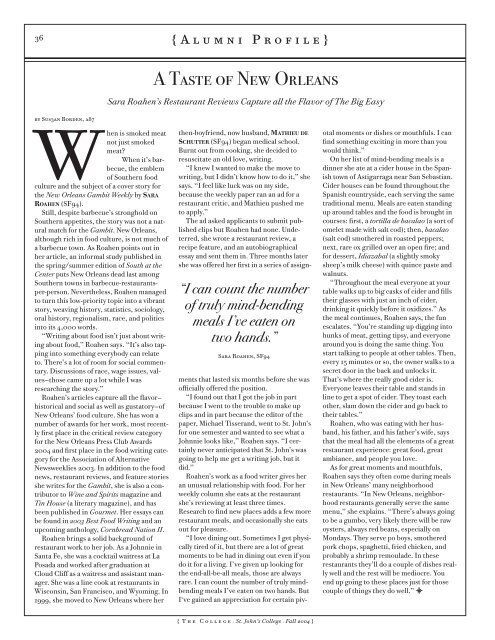Magazine - summer 03 - St. John's College
Magazine - summer 03 - St. John's College
Magazine - summer 03 - St. John's College
Create successful ePaper yourself
Turn your PDF publications into a flip-book with our unique Google optimized e-Paper software.
36<br />
{Alumni Profile}<br />
A Taste of New Orleans<br />
Sara Roahen’s Restaurant Reviews Capture all the Flavor of The Big Easy<br />
by Sus3an Borden, a87<br />
When is smoked meat<br />
not just smoked<br />
meat?<br />
When it’s barbecue,<br />
the emblem<br />
of Southern food<br />
culture and the subject of a cover story for<br />
the New Orleans Gambit Weekly by SARA<br />
ROAHEN (SF94).<br />
<strong>St</strong>ill, despite barbecue’s stronghold on<br />
Southern appetites, the story was not a natural<br />
match for the Gambit. New Orleans,<br />
although rich in food culture, is not much of<br />
a barbecue town. As Roahen points out in<br />
her article, an informal study published in<br />
the spring/<strong>summer</strong> edition of South at the<br />
Center puts New Orleans dead last among<br />
Southern towns in barbecue-restaurantsper-person.<br />
Nevertheless, Roahen managed<br />
to turn this low-priority topic into a vibrant<br />
story, weaving history, statistics, sociology,<br />
oral history, regionalism, race, and politics<br />
into its 4,000 words.<br />
“Writing about food isn’t just about writing<br />
about food,” Roahen says. “It’s also tapping<br />
into something everybody can relate<br />
to. There’s a lot of room for social commentary.<br />
Discussions of race, wage issues, values—those<br />
came up a lot while I was<br />
researching the story.”<br />
Roahen’s articles capture all the flavor—<br />
historical and social as well as gustatory—of<br />
New Orleans’ food culture. She has won a<br />
number of awards for her work, most recently<br />
first place in the critical review category<br />
for the New Orleans Press Club Awards<br />
2004 and first place in the food writing category<br />
for the Association of Alternative<br />
Newsweeklies 20<strong>03</strong>. In addition to the food<br />
news, restaurant reviews, and feature stories<br />
she writes for the Gambit, she is also a contributor<br />
to Wine and Spirits magazine and<br />
Tin House (a literary magazine), and has<br />
been published in Gourmet. Her essays can<br />
be found in 20<strong>03</strong> Best Food Writing and an<br />
upcoming anthology, Cornbread Nation II.<br />
Roahen brings a solid background of<br />
restaurant work to her job. As a Johnnie in<br />
Santa Fe, she was a cocktail waitress at La<br />
Posada and worked after graduation at<br />
Cloud Cliff as a waitress and assistant manager.<br />
She was a line cook at restaurants in<br />
Wisconsin, San Francisco, and Wyoming. In<br />
1999, she moved to New Orleans where her<br />
“I can count the number<br />
of truly mind-bending<br />
meals I’ve eaten on<br />
two hands.”<br />
Sara Roahen, SF94<br />
then-boyfriend, now husband, MATHIEU DE<br />
SCHUTTER (SF94) began medical school.<br />
Burnt out from cooking, she decided to<br />
resuscitate an old love, writing.<br />
“I knew I wanted to make the move to<br />
writing, but I didn’t know how to do it,” she<br />
says. “I feel like luck was on my side,<br />
because the weekly paper ran an ad for a<br />
restaurant critic, and Mathieu pushed me<br />
to apply.”<br />
The ad asked applicants to submit published<br />
clips but Roahen had none. Undeterred,<br />
she wrote a restaurant review, a<br />
recipe feature, and an autobiographical<br />
essay and sent them in. Three months later<br />
she was offered her first in a series of assignments<br />
that lasted six months before she was<br />
officially offered the position.<br />
“I found out that I got the job in part<br />
because I went to the trouble to make up<br />
clips and in part because the editor of the<br />
paper, Michael Tisserand, went to <strong>St</strong>. John’s<br />
for one semester and wanted to see what a<br />
Johnnie looks like,” Roahen says. “I certainly<br />
never anticipated that <strong>St</strong>. John’s was<br />
going to help me get a writing job, but it<br />
did.”<br />
Roahen’s work as a food writer gives her<br />
an unusual relationship with food. For her<br />
weekly column she eats at the restaurant<br />
she’s reviewing at least three times.<br />
Research to find new places adds a few more<br />
restaurant meals, and occasionally she eats<br />
out for pleasure.<br />
“I love dining out. Sometimes I get physically<br />
tired of it, but there are a lot of great<br />
moments to be had in dining out even if you<br />
do it for a living. I’ve given up looking for<br />
the end-all-be-all meals, those are always<br />
rare. I can count the number of truly mindbending<br />
meals I’ve eaten on two hands. But<br />
I‘ve gained an appreciation for certain pivotal<br />
moments or dishes or mouthfuls. I can<br />
find something exciting in more than you<br />
would think.”<br />
On her list of mind-bending meals is a<br />
dinner she ate at a cider house in the Spanish<br />
town of Astigarraga near San Sebastian.<br />
Cider houses can be found throughout the<br />
Spanish countryside, each serving the same<br />
traditional menu. Meals are eaten standing<br />
up around tables and the food is brought in<br />
courses: first, a tortilla de bacalao (a sort of<br />
omelet made with salt cod); then, bacalao<br />
(salt cod) smothered in roasted peppers;<br />
next, rare ox grilled over an open fire; and<br />
for dessert, Idiazabal (a slightly smoky<br />
sheep’s milk cheese) with quince paste and<br />
walnuts.<br />
“Throughout the meal everyone at your<br />
table walks up to big casks of cider and fills<br />
their glasses with just an inch of cider,<br />
drinking it quickly before it oxidizes.” As<br />
the meal continues, Roahen says, the fun<br />
escalates. “You’re standing up digging into<br />
hunks of meat, getting tipsy, and everyone<br />
around you is doing the same thing. You<br />
start talking to people at other tables. Then,<br />
every 15 minutes or so, the owner walks to a<br />
secret door in the back and unlocks it.<br />
That’s where the really good cider is.<br />
Everyone leaves their table and stands in<br />
line to get a spot of cider. They toast each<br />
other, slam down the cider and go back to<br />
their tables.”<br />
Roahen, who was eating with her husband,<br />
his father, and his father’s wife, says<br />
that the meal had all the elements of a great<br />
restaurant experience: great food, great<br />
ambiance, and people you love.<br />
As for great moments and mouthfuls,<br />
Roahen says they often come during meals<br />
in New Orleans’ many neighborhood<br />
restaurants. “In New Orleans, neighborhood<br />
restaurants generally serve the same<br />
menu,” she explains. “There’s always going<br />
to be a gumbo, very likely there will be raw<br />
oysters, always red beans, especially on<br />
Mondays. They serve po boys, smothered<br />
pork chops, spaghetti, fried chicken, and<br />
probably a shrimp remoulade. In these<br />
restaurants they’ll do a couple of dishes really<br />
well and the rest will be mediocre. You<br />
end up going to these places just for those<br />
couple of things they do well.” x<br />
{ The <strong>College</strong> • <strong>St</strong>. John’s <strong>College</strong> • Fall 2004 }

















